Every year there are new trends and methods in the Healthcare industry, which take the world of medicine to a different level. The ground breaking Technologies, methodologies and practices are helping patients to combat diseases by not just managing them but altering them from the root.
Obesity and diabetes have become the biggest concern in the Healthcare industry today. Although there are various techniques and methods to help control obesity, medication for diabetes is still a challenge. Scientists and researchers are not dedicating that time and energy to come up with new ways to control these two diseases; they are also looking at other methods, which can help treat diabetes and obesity.
The success of Skin Grafting so far
Skin grafting and organ transplant may soon become a new hope for obesity and diabetic patients. With the help of a gene editing method called CRISPR, scientists are working on a way to come up with the new method of treating diabetic and obese people. Presently this method is being practiced on mice. They are being fed on high fat diets for inducing Obesity.
We all know that the use of artificial skin has come in very handy to help people in a variety of ways, including treating burn victims. Now researchers are looking at another method by using artificial skin to help people with weaker immune systems through a stem cell generated skin transplant. So far the success of this method has been seen in the lab mice having a low immune system.
However, the latest breakthrough in the study showed that even wild mice have the benefit to avail this treatment in a very successful manner. The teams of researchers there are working on this front also have a hope that very soon they will be able to treat various other health diseases with the help of gene editing and skin grafting.
The area of concerns that still need to be answered
This approach is not a 100% cure for obesity and diabetes, but it helps in the management of the glucose levels in the body. It also provides the necessary support in the prevention of Obesity.
The team of researchers headed by The University of Chicago’s Ben May Department for Cancer Research’s assistant professor Xiaoyang Wu, is trying to come up with a more affordable and safer approach of introducing genes into the human body, in comparison to the various approaches there are today.
One of the typical techniques that they plan to come up with is by using the skin grafting approach by introducing viruses into the human body that contain the altered genes. This in turn would help the immune system in responding more promptly which may be good in one way but can also be riskey and even fatal. As much as this treatment could provide a new ray of hope for patients with diabetes and obesity, the concern that is yet to be answered is about the possibility of developing tumors, which could be side effect for the gene altering technique.
The CRISP- gene editing method that the team used focuses on the development of altered jeans which test the production of insulin by stimulating the pancreas. Skin grafting, which is an already established process, was their next line of action, which was used on the lab mice by embedding skin grafts that contain the altered gene. As per the claims made by the team, this method can surely help in the prevention of type 2 diabetes which is one of the health factors associated with obese patient are that have a problem with the insulin levels .
In addition, there are still a lot of questions and concerns revolving around the success of this form of trip. The train truly deserves a note of appreciation for the efforts that they are trying to put in to take the Healthcare sector to a new level by coming up with this innovative procedure.
The success of this method will eventually unwrap when the study starts working on humans instead of lab mice. For now, this interesting concept does show a Ray of hope in the upcoming years of treating patients who are prone or presently diagnosed with diabetes and Obesity.







